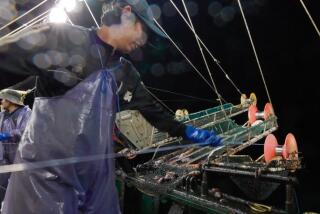Warnings on Canned Tuna Urged
New signs in California grocery stores and restaurants warn consumers, especially pregnant women and children, about the dangers of eating fish that contains mercury. But a battle is being waged over whether the warnings go far enough to protect the public.
Toxicologists agree that women of childbearing age and children should avoid swordfish, shark, king mackerel and tilefish and instead eat salmon, shrimp, sardines, catfish, scallops and other seafood with little or no detectable mercury.
But it is canned tuna -- by far the most popular seafood among American adults and children -- that has fueled a political and legal debate over mercury advisories in California stores and restaurants.
Many stores posted notices next to fresh and frozen fish in February, shortly after California Atty. Gen. Bill Lockyer sued seven grocery chains.
Lockyer alleges that the stores violated Proposition 65, a state law that requires businesses to post “clear and reasonable” warnings when exposing people to chemicals that cause cancer or reproductive harm.
The signs -- based on an advisory from the U.S. Food and Drug Administration and considered an interim measure at stores until the lawsuits are settled -- tell pregnant and nursing mothers, women who may become pregnant and young children to eat no swordfish, shark, king mackerel and tilefish.
They also are advised to “limit their consumption of other fish, including fresh or frozen tuna” and to eat no more than 12 ounces of various fish per week.
The signs give no specific advice about canned tuna, saying only, in smaller type, that “mercury levels in canned tuna vary, but on average are lower than levels in many other fish.” No signs are posted in aisles where canned fish is sold.
Minus the mercury, fish, which contains omega-3 fatty acids, is a highly nutritious food that keeps hearts healthy.
The blood of one in 12 Americans exceeds the Environmental Protection Agency’s “safe” level for mercury, according to data released in January by the Centers for Disease Control and Prevention. And among Californians, particularly upper-income residents, recent testing has found that high mercury levels are even more common.
Mercury is naturally found in the environment, but much of it also comes from coal-fired power plants and municipal waste-burning facilities. It settles in oceans and rivers and accumulates in predatory fish such as swordfish and shark that are large and long-lived.
A San Francisco physician, Dr. Jane Hightower, began sampling patients in 2000 and discovered that nine out of 10 of her patients had levels of mercury in their bodies that exceeded the EPA’s recommendation. Hightower’s findings were published in November in a study in the journal Environmental Health Perspectives.
Hightower, who tested more than 200 patients, decided to do so after she and a dermatologist colleague stumbled upon mercury while they were trying to figure out why a patient’s hair was falling out. Hair loss is a symptom of mercury poisoning.
Hightower conducted a survey of her patients’ diets and eventually concluded that fish bought in stores and restaurants was the source of the mercury.
On average, a swordfish steak or piece of shark contains about six times as much mercury as the same quantity of canned tuna, 2001 data from the FDA indicate. But because people eat much more tuna than any other fish, the bulk of the mercury in a person’s body could come from canned tuna.
Hightower said the Proposition 65 signs and federal advisories are a good first step, but that better efforts are needed to send the right message to fish-eaters. The California Medical Assn. passed a resolution in March calling for notices wherever fish is sold, including labels on canned tuna.
“I was glad to see the signs go up,” Hightower said. “People may just lean over the counter and ignore them, but at least the information is available and a lot more conspicuous.”
Still, she said, the signs are too general. “What if people decide to eat grouper or lobster or canned albacore tuna?” which she said can have more than 1 part per million of mercury. “We need education on all the fish.”
The tuna industry, however, is vigorously opposed to warnings that specify its products. Star-Kist Seafood, a division of Del Monte Foods, has asked grocery stores to keep warnings out of canned-food aisles, and the U.S. Tuna Foundation is campaigning to keep federal advisories from targeting canned tuna.
The Tuna Foundation, representing processors and marketers, says that “canned tuna has only trace amounts, well below all safety levels” and “continues to be a safe, convenient, affordable and delicious source” of protein, vitamins and nutrients.
The FDA has found wide variation in mercury levels in cans of tuna, from none detectable to around 1 part per million, a level that compares with that in swordfish, shark and king mackerel. Chunk light tuna has less mercury than albacore or white tuna. Other types of seafood with fairly high mercury levels include red snapper, grouper, orange roughy and fresh tuna such as ahi (yellowfin) and albacore, according to FDA data.
So far, California stores say the signs have had no noticeable effect on people buying fish.
“We haven’t seen a change in sales,” said Stacia Levenfeld, a spokeswoman for Albertsons, which has more than 400 stores in California. “We’ve had very few, if any, questions or concerns from the public.”
“It is not our objective to discourage people from eating fish,” said Tom Dresslar, a spokesman for the attorney general’s office.
“We believe it should be a continued important source of protein in Californians’ diet. But the fish we’re talking about in these lawsuits is high in mercury, and businesses have a legal obligation to warn people.”
In a pregnant woman’s body, mercury crosses into the developing brain of a fetus, reducing a child’s intelligence, especially vocabulary and memory, according to scientific studies.
Men and women face dangers from fish with high mercury levels because mercury has been linked to an increased risk of heart attacks.
About 60,000 children are born in the U.S. every year to women whose blood exceeds the EPA’s safety level of 5.8 parts per billion of mercury, according to a report from the National Academy of Sciences. Children’s intelligence is reduced at 58 parts per billion, but the EPA built in a tenfold safety factor.
Hightower’s survey determined that swordfish, a comparatively expensive fish, was most often responsible for excessive mercury in her patients, many of whom are well-to-do.
However, a number of her patients, including children, had eaten no fish other than canned tuna and still exceeded the EPA’s safety level, she said.
Nationally, children eat more than twice as much tuna as any other fish, according to a Department of Agriculture report. Tuna also is the top choice of women of childbearing age, followed by shrimp, cod and salmon.
“The time has come to label canned tuna and other fish that pose a mercury poisoning threat. Our children’s health is too important to stall any longer,” said Michael Bender of the Mercury Policy Project, an environmental group.
Dresslar said the signs could change when a settlement is reached with the grocery stores. The attorney general’s office, pressured by both sides, has begun testing cans at California stores to get more reliable data, he said.
The grocery chains singled out in the lawsuit are Albertsons, Kroger (which owns Ralphs), Safeway, Trader Joe’s, Whole Foods, Andronico’s and Costco. In April, the attorney general also sued the owners of 16 restaurant chains, including Chart House and Red Lobster, seeking warnings.
Restaurants last month began posting notices that are much less specific than the grocery store signs. The signs do not mention fish, stating only that “chemicals known ... to cause cancer, or birth defects or other reproductive harm may be present.”
The restaurant sign “is basically useless for consumers,” Dresslar said. “It leaves them wondering which menu items contain chemicals.”
But until the lawsuits are resolved, the California Restaurant Assn. has advised its members to post the general warning. The 1986 law allows businesses to avoid future liability if they post it, Dresslar said.
“We’re not opposed to warnings, we just don’t want it to be the first thing that consumers are hit with at the front door, and we definitely don’t want it required on menus,” said John Dunlap, president of the restaurant association.
For more information on mercury in fish, consult the following Web sites: FDA: www.cfsan.fda.gov, or EPA: www.epa.gov/mercury. Or call the FDA toll-free at (888) SAFEFOOD.
More to Read
Inside the business of entertainment
The Wide Shot brings you news, analysis and insights on everything from streaming wars to production — and what it all means for the future.
You may occasionally receive promotional content from the Los Angeles Times.










